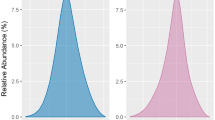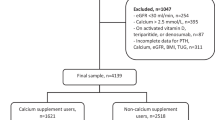Abstract
Purpose. To determine the pharmacokinetics and absolute bioavailability of risedronate after single-dose oral administration of 30 mg risedronate as a tablet and an aqueous solution, and 0.3 mg risedronate as an intravenous infusion.
Methods. This study was a randomized, three-treatment, four-period, partial replicate crossover study involving 33 healthy volunteers. Treatments were administered 7 weeks apart, and the third treatment was repeated during the fourth period. Serum and urine were collected over 72 hours and 672 hours, respectively.
Results. Following intravenous administration, renal clearance accounted for 87% of total clearance, with 65% of the dose excreted within 24 hours and 85% of the dose excreted within four weeks. The absolute bioavailability was approximately 0.62% after both oral formulations, and the relative bioavailability of the tablet compared with the oral solution was 104%. The rate and extent of absorption from the two formulations were bioequivalent based on the range proposed for highly variable drugs. Intrasubject variability following oral administration was 50-80%, and was primarily associated with absorption.
Conclusion. The majority of the total clearance after intravenous administration of risedronate was renal clearance, indicating that only a small percentage of a systemic dose is potentially incorporated, or “cleared,” into bone. The absolute bioavailability of orally administered risedronate is ∼0.6%, and is independent of formulation. Variability in the pharmacokinetics following oral administration is primarily associated with intrasubject variability in absorption.
Similar content being viewed by others
REFERENCES
P. D. Miller, J. P. Brown, E. S. Siris, et al. Randomized, double-blind comparison of risedronate and etidronate in the treatment of Paget's disease of bone. Am. J. Med. 106:513-520 (1999).
J. Y. Reginster, H. W. Minne, O. H. Sorensen, et al. Randomized trial of the effects of risedronate on vertebral fractures in women with established postmenopausal osteoporosis. Osteoporos. Int. 11:83-91 (2000).
S. T. Harris, N. B. Watts, H. K. Genant, et al. Effects of risedronate treatment on vertebral and nonvertebral fractures in women with postmenopausal osteoporosis. JAMA 282:1344-1352 (1999).
W. K. Sietsema, F. H. Ebetino, A. M. Salvagno, and J. A. Bevan. Antiresorptive dose-response relationships across three generations of bisphosphonates. Drugs Exp. Clin. Res. 15:389-396 (1989).
J. McOsker. Preclinical pharmacology of risedronate, a 3rd generation bisphosphonate. J. Bone Miner. Res. 10:S302 (1990).
D. Y. Mitchell, R. A. Eusebio, L. E. Dunlap, et al. Risedronate gastrointestinal absorption is independent of site and rate of administration. Pharm. Res. 15:228-232 (1998).
D. Y. Mitchell, R. A. Eusebio, N. A. Sacco-Gibson, et al. Dose-proportional pharmacokinetics of risedronate on single-dose oral administration to healthy volunteers. J. Clin. Pharmacol. 40:1-8 (2000).
D. Mitchell, R. Eusebio, K. Pallone, et al. Bisphosphonate pharmacokinetics: Use of simultaneous modeling of urine and serum data to determine parameters. Clin. Pharmacol. Ther. 61:155 (1997).
D. Y. Mitchell, J. V. St. Peter, R. A. Eusebio, et al. Effect of renal function on risedronate pharmacokinetics after a single oral dose. Br. J. Clin. Pharmacol. 49:215-222 (2000).
B. S. DeSilva, D. J. Whitham, B. Bhullar, et al. Validation of an enzyme linked immunosorbent assay for the determination of risedronate in human serum. Pharm. Sci. 1:S26 (1998).
Statistical Consultants Inc. PCNONLIN and NONLIN84: Software for the statistical analysis of nonlinear models. Amer. Stat. 40:52 (1986).
D. Y. Mitchell, M. A. Heise, K. A. Pallone, et al. The effect of dosing regimen on the pharmacokinetics of risedronate. Brit. J. Clin. Pharm. 48:536-542 (1999).
H. G. Boxenbaum, S. Riegelman, and R. M. Elashoff. Statistical estimations in pharmacokinetics. J. Pharmacokinet. Biopharm. 2:123-148 (1974).
M. Gibaldi and D. Perrier. Pharmacokinetics. 2nd ed., Marcel Dekker Inc, New York, 1982.
J. G. Wagner. Linear pharmacokinetic equations allowing direct calculations of many needed pharmacokinetic parameters from the coefficients and exponents of polyexponential equations which have been fitted to the data. J. Pharmacokinet. Biopharm. 4:443-467 (1976).
J. D. Eisenhart, V. M. Chinchilli. In Proceedings of the Biopharmaceutical Section of the American Statistical Association, pp. 37-42, 1990.
L. Hyldstrup, G. Flesch, and S. A. Hauffe. Pharmacokinetic evaluation of pamidronate after oral administration: A study on dose proportionality, absolute bioavailability, and effect of repeated administration. Calcif. Tissue Int. 53:297-300 (1993).
B. J. Gertz, S. D. Holland, W. F. Kline, et al. Studies of the oral bioavailability of alendronate. Clin. Pharmacol. Ther. 58:288-298 (1995).
G. J. Yakatan, W. J. Poynor, R. L. Talbert, et al. Clodronate kinetics and bioavailability. Clin. Pharmacol. Ther. 31:402-410 (1982).
J. H. Powell and B. R. DeMark. In S. Garattini (ed.), Bone Resorption, Metastasis, and Diphosphonates, Raven Press, New York, 1985, pp. 41-49.
L. N. Sansom, J. Necciari, and J. F. Thiercelin. Human pharmacokinetics of tiludronate. Bone 17:479S-483S (1995).
V. P. Shah, A. Yacobi, W. H. Barr, et al. Workshop report: Evaluation of orally administered highly variable drugs and drug formulations. Pharm. Res. 13:1590-1594 (1996).
K. A. Conrad and S. M. Lee. Clodronate kinetics and dynamics. Clin. Pharmacol. Ther. 30:114-120 (1981).
R. R. Recker and P. D. Saville. Intestinal absorption of disodium ethane-1-hydroxy-1,1-diphosphonate (Disodium Etidronate) using a deconvolution technique. Toxicol. Appl. Pharmacol. 24:580-589 (1973).
S. A. Khan, J. A. Kanis, S. Vasikaran, et al. Elimination and biochemical responses to intravenous alendronate in postmenopausal osteoporosis. J. Bone Miner. Res. 12:1700-1707 (1997).
J. Y. Reginster. Oral tiludronate: Pharmacological properties and potential usefulness in Paget's disease of bone and osteoporosis. Bone 13:351-354 (1992).
Author information
Authors and Affiliations
Rights and permissions
About this article
Cite this article
Mitchell, D.Y., Barr, W.H., Eusebio, R.A. et al. Risedronate Pharmacokinetics and Intra- and Inter-Subject Variability Upon Single-Dose Intravenous and Oral Administration. Pharm Res 18, 166–170 (2001). https://doi.org/10.1023/A:1011024200280
Issue Date:
DOI: https://doi.org/10.1023/A:1011024200280




